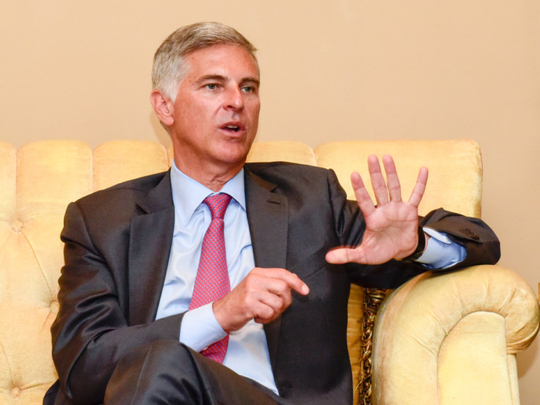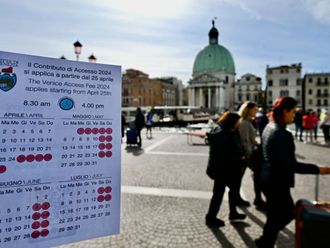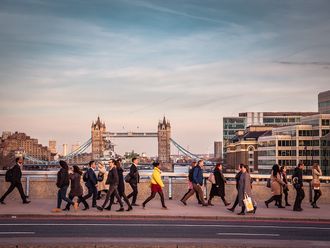
Dubai: At the turn of the century, Hilton opened a resort property in Dubai on a quiet stretch of beach on the outskirts of the city. Today that property is at the centre of Dubai’s flagship beachfront tourist district: JBR Beach.
The area, called Dubai Marina, is home to several luxury five-star properties and glitzy all-night restaurants, cafes and boutiques offering a variety of global cuisines and shopping. Connected to the international airport by a six-lane highway and a driverless metro, the 35-km trip is marked by tall skyscrapers, flashy car showrooms and international landmarks such as the Burj Khalifa.
“So obviously, a lot has happened in Dubai, in a very positive way,” Christopher J. Nassetta, the Chief Executive Officer of Hilton, told Gulf News recently in an exclusive interview.
Nassetta first came to Dubai more than a decade ago and the emirate hasn’t failed to surprise the well travelled executive every time since then with its transformation from a sleepy fishing village a few decades ago to one of the biggest trade and tourism hubs in the Middle East region.
Much of the region’s growth in recent years was led by the energy-exporting states of the Gulf Cooperation Council (GCC). These countries are now pushing hard to build their non-oil economies and reduce the dependence on oil with the help of the private sector.
Hilton is betting on that growth, and the people it will bring along with it.
This region is a “huge priority” for Hilton, says Nassetta, noting, “A lot of people want to be here, so we have to succeed here.”
The company, which has some 130 properties in the Middle East, Africa and Turkey and about 150 in the pipeline, is currently witnessing “around 20 per cent” volume and value growth in the region.
Over the next five to 10 years, the US hotel chain plans to double and triple its presence in this region, Nassetta says, adding that the Middle East is a “relatively small but a fast-growing percentage” of Hilton’s global business.
The Hilton chief expects the Middle East’s contribution to its global business to jump from “single digits at the moment” to double-digits “over the next decade”.
Mid-market growth
The bulk of the Middle East growth in rooms over the next three to four years will come at the higher end, but that percentage will start to shift over time to being more balanced between upper end and mid-market, Nassetta says. This, he noted, reflects the global trend, especially in the emerging markets of Asia and Latin America.
“As middle classes grow in these parts of the world, the mid-market is the product that they can afford,” he added.
“It doesn’t mean that we are abandoning the upper end of the market. We are as active as anybody out there,” Nassetta said. “We love our Hilton core brand but we want to be able to serve all these different needs.”
The company, he says, will continue to do more of its flagship Hilton-branded hotels but also offer other brands in its portfolio catering to different segments of the market. “Because that’s what ultimately allows us to build our network out and build loyalty in a region,” Nassetta said.
Targeting the mid-market segment, Hilton already has three Hilton Garden Inns in the UAE, and is getting ready to open the largest Hampton property in the world, with 420 rooms “sometime real soon” in Dubai.
“I met with the [Dubai] Ruler around three years ago and had the discussion about the mid-market. He was very keen on the idea, for all the right reasons,” Nassetta said.
Saturation?
Asked if the luxury end of the market had reached a saturation point here, Nassetta said: “I don’t think so.”
There has been enough demand in this segment, but probably not as much as the mid-market, he added.
The hotel chain offers premium brands such as Hilton, DoubleTree, Waldorf Astoria and Conrad in the region. “You are going to see more of those represented. So we think there are great opportunities for the high end,” Nassetta said.
UAE and Saudi Arabia
Like any market, the Hilton CEO says the UAE will have fluctuations that relate to basic supply and demand, but he sees both intermediate and long-term prospects to be quite strong in the country.
“The underlying trends in this market are spectacular, because there are a lot of reasons that a lot of people want to be here. It is geographically incredibly fortunate for where it is,” Nassetta said.
The UAE has done a “really good job” in building out infrastructure such as seaports and airports to get people in, according to the Hilton chief. This has been supported by the creation of a resort-like environment in the city, with multiple options for entertainment.
“So you build it and they will come. And they are coming and are going to continue to come for decades and decades,” he added.
Another market in the Middle East that Hilton is bullish on is Saudi Arabia. “We are the biggest player there,” Nassetta said. Hilton has 11 operating hotels in the kingdom with 33 in the pipeline.
Partnerships
Nassetta said he hopes that Hilton’s existing partnerships in the region will result in new ventures.
Earlier this month, the company signed a deal with Dubai developer Nakheel for two hotels — to be operated under the DoubleTree by Hilton brand — bringing 704 new hotel rooms and serviced apartments to Dubai.
Hilton is also talking to a lot of others (potential partners) in the region for future deals, Nassetta said, without divulging details.
Hilton brands
Six of 14 brands in Hilton’s global portfolio are present today in this market, serving different segments. Three more — Curio, Hampton and Embassy Suites — will be added in the near future.
“You will eventually see Tru and Tapestry Collection here, and maybe some form of extended stay,” Nassetta said.
But it will be a while before all 14 Hilton brands are here, he added. “The strategy in whether we launch a new brand globally or take existing brands and layer them in markets has just a lot to do with following the demand pattern.”
Challenges and growth
Several parts of the Middle East region are engulfed in conflicts and political instability, which has had a slight impact on Hilton’s business, says Nassetta.
“The region broadly has seen somewhat slower growth, certainly over the last year or so. And I expect [the same] definitely this year, and potentially in the next year … I am not saying Dubai. I am saying [in] the broader region,” he added.
Uncertainty following a US travel ban from several countries in the Middle East earlier this year, which was blocked by US courts, also impacted several players in the tourism industry, especially the airlines.
“It’s a little bit early to tell. It certainly is not helping our business,” Nassetta said, when asked about the travel ban’s impact on Hilton. International arrivals represent a small part of Hilton’s aggregate enterprise-wide US business, he added.
“As is the case with any new administration, they [US government] are trying to figure it out. And I think we have to give them some time to do [that], which is balancing safety and security,” Nassetta said.
The US travel ban may have contributed to making Europe more appealing as a destination for some people, according to him.
European economy
Europe as a region is “performing unbelievably well right now” for Hilton, Nassetta said, despite tourism suffering in several countries there due to a spate of recent terror attacks.
“Not withstanding Brexit, the European economy broadly is doing a little bit better. The currency issues are helping — typically with the [British] pound, but euro broadly has been weaker, it’s cheaper,” Nassetta said.
“So you put those things together and inbound international tourism to Europe year-to-date is up big time,” he said, adding that the numbers are almost up by 20-30 per cent.
For Hilton, which operates more than 5,000 properties worldwide under different brands, the Middle East is a relatively small but increasingly important market to drive growth.
“Simple underlying philosophy that drives me every day is serve any customer, anywhere they want to be for any travel need that they have,” Nassetta said. “The Middle East is a huge priority.”












